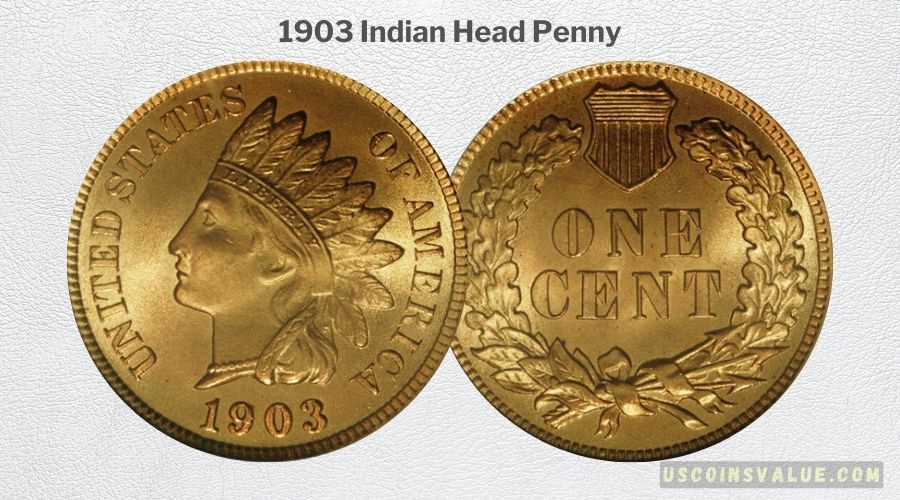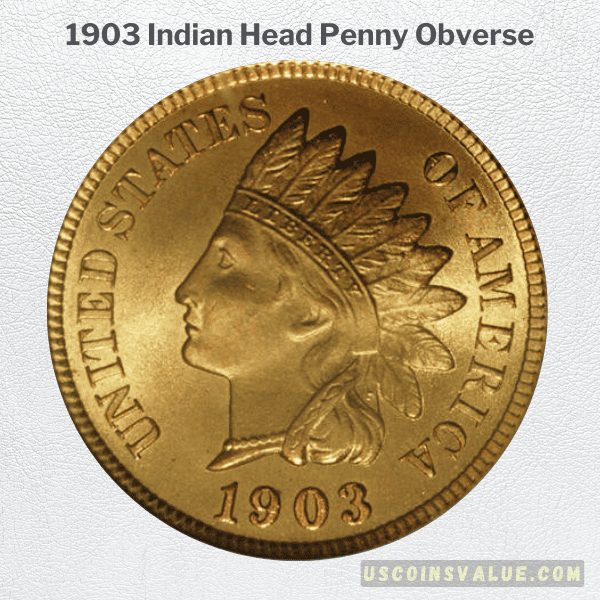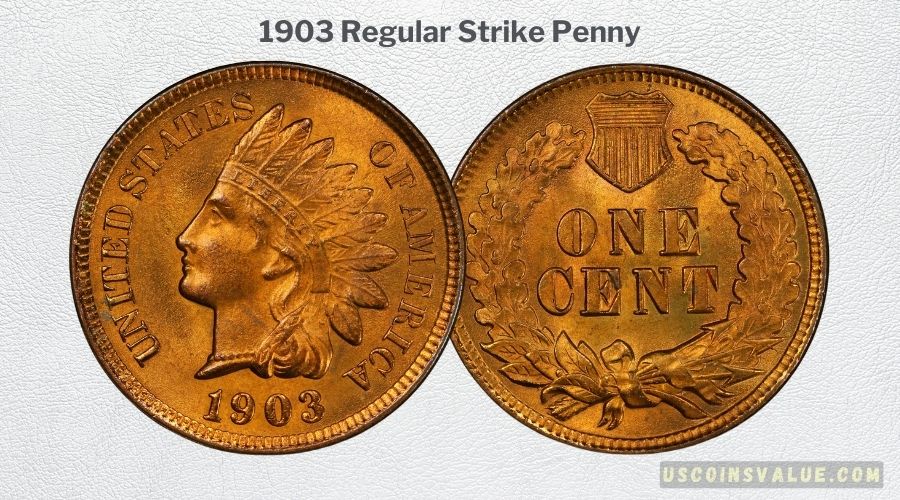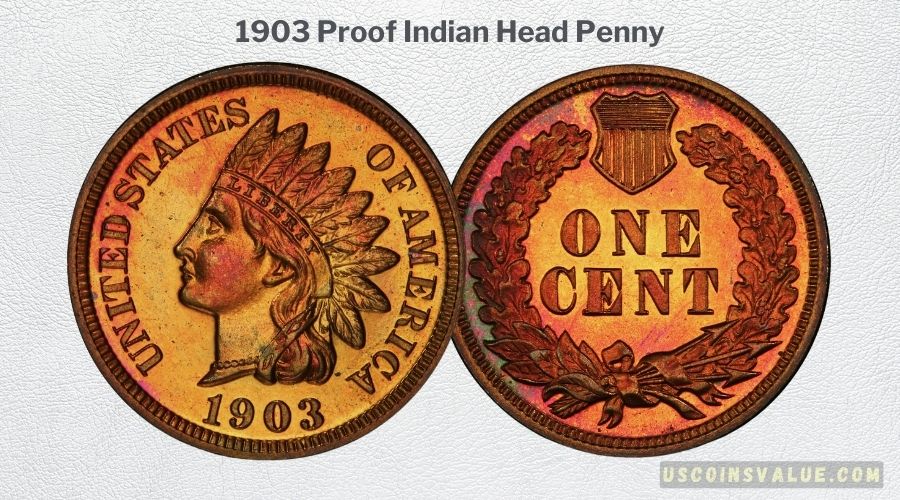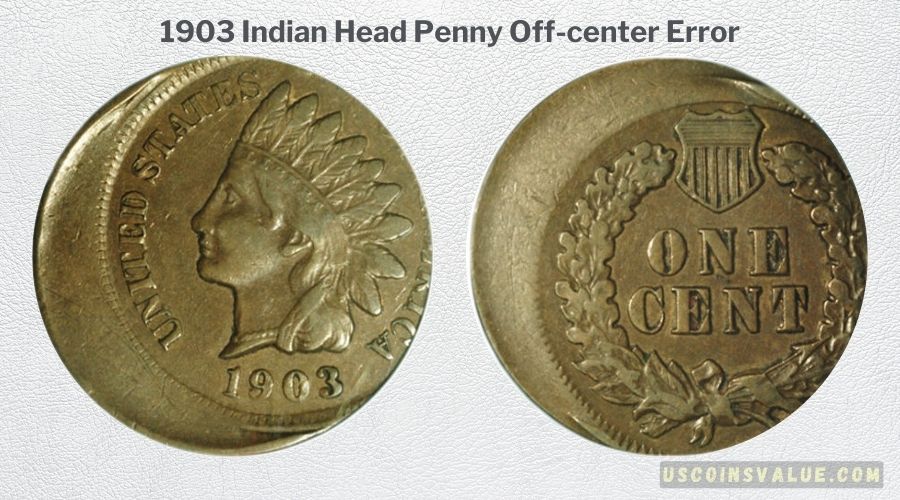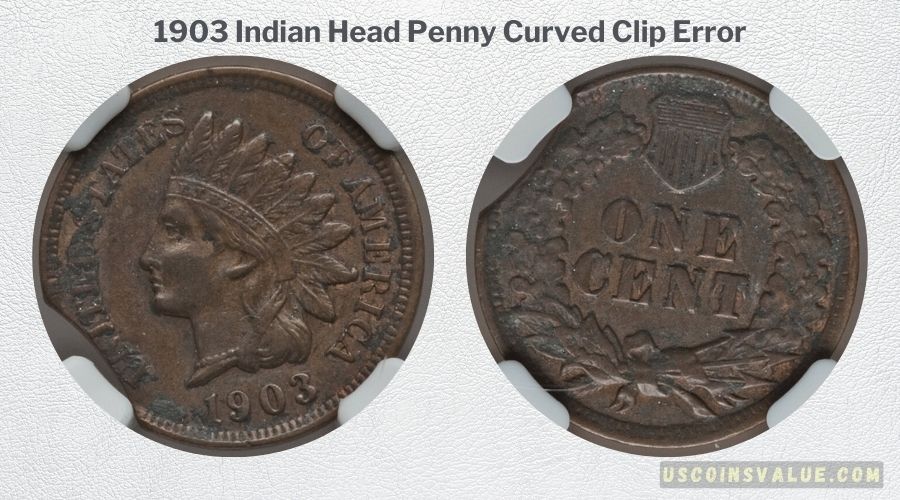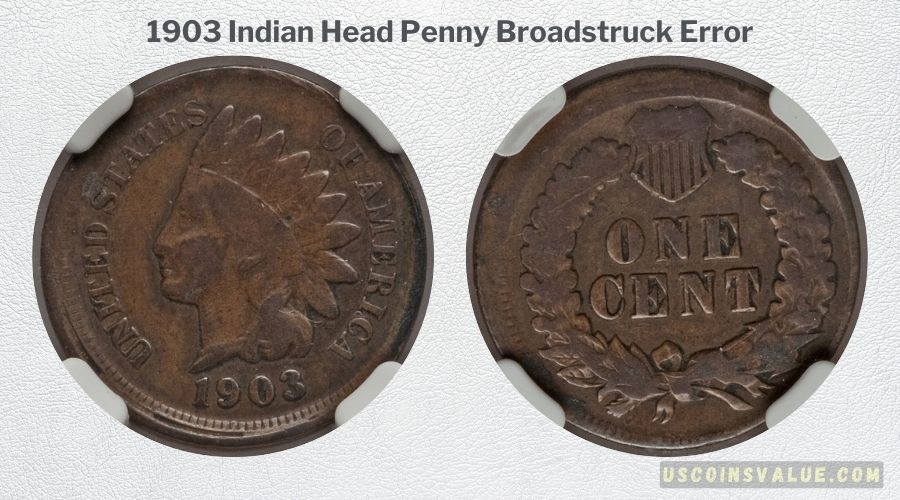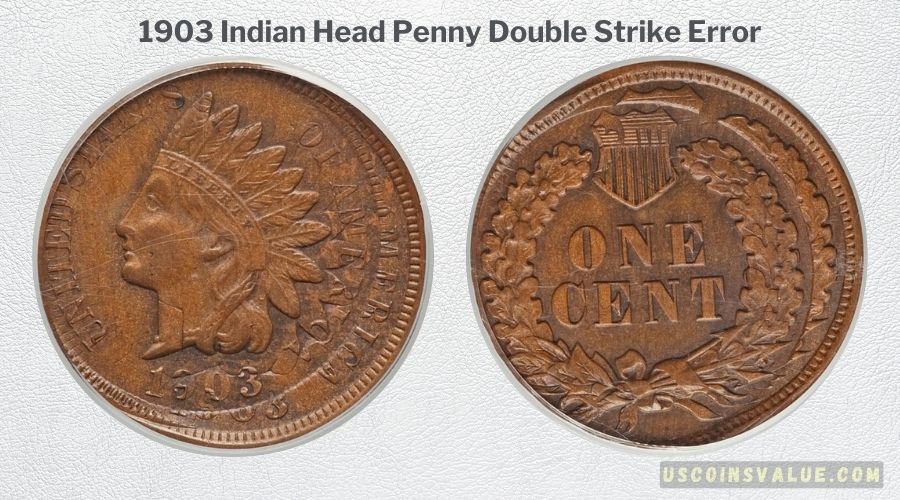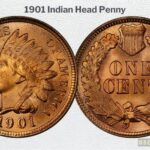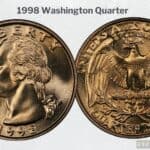The 1903 Indian Head Penny is one of the last coins minted in the famous category of coins known as the “Indian Head Pennies” or “Indian Cents”. These coins hold much significance in American history, so if you find yourself with one, don’t be in a hurry to throw it out just yet.
On average, coin collectors pay between $1.50 and $35 for a coin between Average and Mint State Brown condition and if by some lucky twist of fate, you find one of these coins in Mint State Red condition, it can sell for as high as $9,000, but the highest recorded sale almost doubles this price at $17,250 and $37,600 for a proof variety.
Besides the 1903 Indian Head Penny value, here, you’ll get to learn the history, mintage, and errors peculiar to this coin.
Background of the 1903 Indian Head Penny
Indian Head Pennies came after the Flying Eagle Pennies, making them the second series of small cents in American history.
The need for the Indian pennies arose because the Flying Eagle Pennies were harder, larger, and more expensive to produce, hence the U.S. Mint introduced the Indian Head Pennies. They were smaller in diameter.
The earlier Indian Head Pennies were minted from copper and nickel clads; however, the U.S. Mint changed the composition of these coins to bronze composites in 1864. Hence, the 1903 Indian Head Penny is not copper-nickel clad but bronze composite.
James B. Longacre, the chief engraver at the U.S Mint at that time, designed the 1903 Indian Head Pennies.
While the Flying Eagle Cent features a flying eagle on its obverse, the Indian Head Cent features an image of a female figure wearing an Indian headdress. Hence the name “Indian Cent”.
1903 Indian Head Penny Features
1903 Indian Head Penny Specifications
- Category: Indian Head Cents or Indian Head Pennies (1859 – 1909)
- Year of Make: 1903
- Mint Branch: Philadelphia (No mint mark)
- Total Mintage: 87,374,704
- Face Value: $0.01
- Composition: 95% Copper, 5% Tin & Zinc (Bronze Composite)
- Weight: 3.11 grams
- Diameter: 19 millimeters
- Thickness: 1.5 millimeters
- Edge: Plain
Obverse & Reverse of the 1903 Indian Head Penny
This penny’s obverse (head) shows the female figure with an Indian head adornment at its center. This figure is believed to be Lady Liberty or James B Longacre’s daughter. It bears the following inscriptions;
- UNITED STATES: On the left side of the coin, in front of the figure head
- OF AMERICA: On the right side of the coin, behind the headdress of the figure head.
- LIBERTY: Across the band of the Indian headdress.
- 1903: At the bottom-center of the coin, just below the portrait of the female figure.
N.B: Earlier Indian Head Pennies bear James Longacre’s initial “L” on their obverse, but pennies struck after 1864 do not hold this inscription.
The reverse (tail) of the 1903 Indian Head Penny showcases a shield at the top-center of the coin, with a wreath that goes around to form a boundary on either side of the shield.
At the bottom center of the coin are three arrows intertwined with the wreath and some ribbons. The single inscription on this side of the coin reads;
- ONE CENT: Inscribed at the center of the coin between the shield and the bunch of arrows.
What are the 1903 Indian Head Penny Varieties?
A coin is typically minted in several varieties, which differ based on its mint location, composition, strike, and finish.
Coins minted across all three U.S Mint locations usually bear either “D,” “S,” or “P,” which corresponds to Denver, San Francisco, and Philadelphia.
The 1903 Indian Head Penny deviates from this norm as it holds no mint mark. This is because it was minted at the Philadelphia Mint, the only mint facility that produced these coins then. Hence, there was no need for a mint mark.
However, this penny was minted in two strikes: the regular strike coins and proof strike coins.
Regular strike coins were produced for mass circulation, while proof coins were minted specially for collectors.
Proof coins often appear shinier and more attractive than regular strike coins because they were struck on specially prepared die planchets; hence, they are valued higher.
We’ll discuss the value of 1903 Indian Head Penny proof coins shortly. For now, take a look at its mintage;
| 1903 (Indian Head Penny Varieties) | Composition | Mint Location | Mintage |
| 1903 (Regular Strike) | 95% Copper and 5% Tin & Zinc (Bronze Composite) | Philadelphia | 85,092,703 |
| 1903 (Proof Strike) | 95% Copper and 5% Tin & Zinc (Bronze Composite) | Philadelphia | 1,790 |
The 1903 Indian Head Penny: How Much Is It Worth Today?
The U.S. Mint brought the 1903 Indian Head Penny into circulation over a century ago, so it is unlikely that you’ll find it in pocket change. But you might be able to find one in 19th-century U.S. coinage coin shops or mixed-date rolls.
If you come across one in circulated average condition today, it should be worth $1.50, with a melt value of $0.0244, while a high grade of MSBN66 can sell for up to $390.
1903 Indian Head Pennies graded MSRB can sell between $115 and $500, while more pristine grades like MSRD are valued between $90 and $9,000.
The summary chart below clearly shows how this coin is valued today.
| Grade (MSRD) | 1903 Indian Head Penny (Regular Strike) | 1903 Indian Head Penny (Proof Strike) |
| 59 | N/A | N/A |
| 60 | N/A | N/A |
| 61 | N/A | N/A |
| 62 | $90 – $100 | N/A |
| 63 | $120 – $150 | $365 |
| 64 | $235 – $300 | $515 |
| 65 | $525 – $700 | $1,100 – $1,350 |
| 66 | $1,150 – $2,300 | $1,900 |
| 67 | $9,000 | $6,500 – $13,500 |
| 68 | N/A | $35,000 |
1903 Indian Head Penny (Regular Strike)
The Philadelphia Mint produced about 85 million 1903 Indian Head Pennies in regular or business strikes as these pennies were intended for circulation.
According to the NGC Price Guide, depending on its condition and color, a 1903 Indian Cent in circulated Brown condition is worth $1.50, while cents in Mint State brown condition can be sold between $40 and $390.
The most recent prices for a 1903 Indian Head Penny are $9,000 and $2,115 in July 2023, but the highest recorded auction price stood at $17,250 in 2004.
Let’s consider some other high auction prices using the chart below;
| Grade | Highest Price & Sale Date | Firm |
| MS67 | $17,250 (2004) | Heritage Auctions |
| MS67 | $16,100 (2008) | Heritage Auctions |
| MS67RD | $15,000 (2021) | Heritage Auctions |
| MS67+RD | $15,000 (2019) | Heritage Auctions |
| MS67RD | $14,100 (2019) | Legend Rare Coin Auctions |
1903 Indian Head Penny (Proof Strike) Value
The proof strike variety of the 1903 Indian Head Pennies possess glossy finishes, making them more valued than regular strike coins. These coins appear mirror-like because they were produced by burnishing planchets before striking them with stainless steel balls.
The Philadelphia Mint only produced about a thousand Proof Cents in 1903, so they are not easy to come by.
If you come across one, there is a high chance it may have lost its luster due to wear, but one in perfect condition can sell for thousands of dollars.
According to recent updates from the NGC Price Guide, a 1903 Indian Head Penny in Proof Brown Condition can be sold between $165 and $1100, while one in Proof Red Brown condition is valued between $210 and $3,800.
A high grade like Proof Red 68 can sell for as much as $35,000, but the most recent price for a 1903 Indian Head Penny was $4,560 in 2023, while the highest recorded auction price was $37,600 in 2017.
Let’s look at some of the highest auction prices recorded for this coin;
| Grade | Highest Price & Sale Date | Firm |
| PR68RD | $37,600 (2017) | Heritage Auctions |
| PR68 | $28,750 (2007) | Heritage Auctions |
| PR68 | $20,700 (2007) | Heritage Auctions |
| PR67 | $17,038 (2015) | Stack’s Bowers |
| PR67+RD | $12,338 (2022) | Legend Rare Coin Auctions |
1903 Indian Head Penny Errors
Error coins are coin misprints in the striking chamber during the minting process. Coins with errors are usually considered more valuable as they are harder to come by.
Some error coins are created by mistake due to faulty equipment, while some errors are man-made to create rarity.
The 1903 Indian Head Penny exists in specific errors that make them desirable to coin collectors and investors alike. These errors include the curved clip, off-center, broadstruck, and double die errors.
Off-center Error
When a planchet is about to be struck, it is usually placed between the dies, but if a malfunction occurs and the planchet shifts, the coin can be struck with a design that does not sit at its center. This is known as the off-center error.
Off-center error coins can show designs ranging from 10% to 80% off-center. The more off-center the design is, the higher the coin’s value. Let’s consider some 1903 Indian Head Pennies with this error;
- 1903 1C Indian Cent – Struck 12% Off Center: This error coin was graded VF20 and sold for $126.50 in 2005.
- 1903 1C Indian Cent- Struck 15% Off Center: Sold for $632.50 at grade MS65 Brown in 2010.
- 1903 1C Indian Cent- Struck 15% Off Center: Sold for $632.50 at grade MS64 Brown in 2005.
- 1903 1C Indian Cent – Struck 10% Off Center: Graded XF45, this error coin sold for $211.50 in 2015.
- 1903 1C Indian Cent – Struck 30% Off Center: Sold for $276 in 2005 at grade XF45.
- 1903 1C Indian Cent – Struck 20% Off Center: Graded AU55, this coin sold for $322 in 2005.
Curved Clip Error
Curved clip error coins are formed when the blank metal disc or planchet is incorrectly struck by overlapping on a hole where a different planchet was previously struck.
This error makes a coin appear to have holes or part of its edge missing. For example, consider this 1903 Indian Head Penny with this error;
- 1903 1C Indian Cent – Curved Clip at 6 o’clock: Sold for $506 at grade PR64 Red in 2004.
- 1903 1C Indian Cent – 5% Curved Clip: Sold for $15 in 2005.
- 1903 1C Indian Cent – 5% Curved Clip with Environmental Damage: Sold for $62 in 2012.
Broadstruck Error
Broadstruck error coins are formed when a coin is struck outside its collar, making it appear flatter and without an edge at that spot.
This is a fairly common error that makes the metal spill out of shape during the minting process, forming a coin that appears to have a vague shape or structure. Some 1903 Indian Cents with this error include;
- 1903 1C Indian Cent – Broadstruck: Graded VG8, this error coin sold for $56 in 2010.
- 1903 1C Indian Cent – Broadstruck: Sold for $35 in 2005.
Double Strike Error
Double strike error coins are produced when a coin is struck twice using the same die. This happens when the coining press does not eject a newly minted coin from the striking area, so the coin is struck again.
This error does not just stop at double strikes; a die can strike a coin three, four, or more times. Some coins have even been struck up to 100 times. There are quite a number of 1903 Indian Head Pennies with this error.
- 1903 1C Indian Cent – Struck Twice, Second Strike 65% Off Center: Graded MS62 Brown, this coin sold for $920 in 2011.
- 1903 1C Indian Cent – Double Struck, Second Strike 85% Off Center: Sold for $456 in 2023.
- 1903 1C Indian Cent – Double Struck Rotated in Collar: Graded G6, this error coin sold for $180 in 2023.
- 1903 1C Indian Cent – Double Struck, Second Strike Off Center: Graded AU55, this coin sold for $2,280 in 2022.
- 1903 1C Indian Cent – Double Struck, Second Strike 15% Off Center: Sold for $780 at grade AU58 in 2021.
Conclusion
The 1903 Indian Head Penny can be worth more than $37,000 if you find it pristine. However, this is a challenging feat as this coin has been in circulation for over a century.
If you find a 1903 Indian Cent in good condition, it should still exhibit some of its original shiny red color, while 1903 Cents of proof variety will appear mirror-like.
Before listing your coin for sale, ensure you get it graded by Professional Coin Grading Services or other experienced numismatists to know the exact value of your coin.

